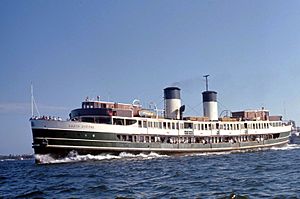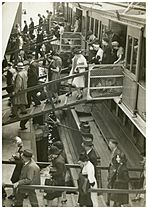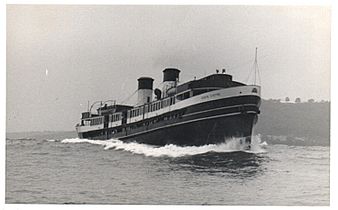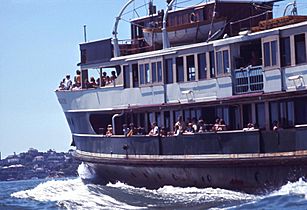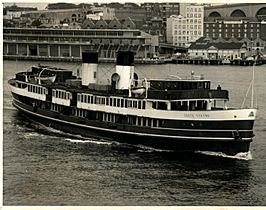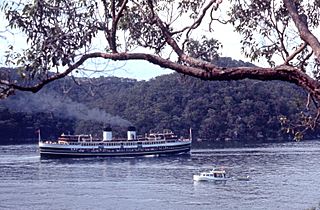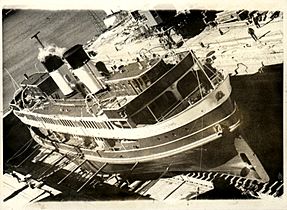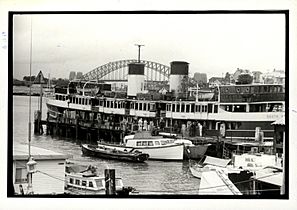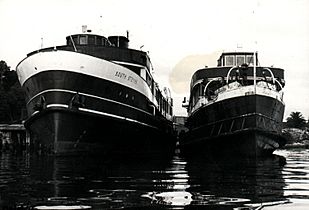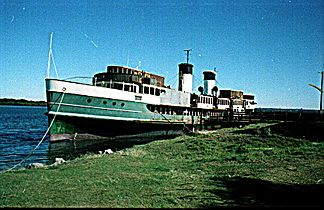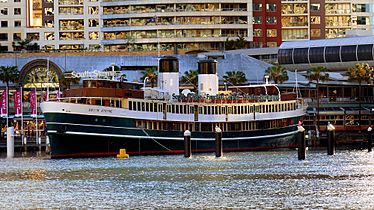SS South Steyne facts for kids
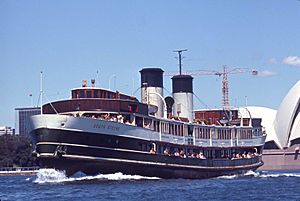
South Steyne on Sydney Harbour, 1970
|
|
Quick facts for kids History |
|
|---|---|
| Name | SS South Steyne |
| Owner | Port Jackson & Manly Steamship Company |
| Route | Manly |
| Builder | Henry Robb, Leith |
| Cost | £141,526 |
| Yard number | 267 |
| Launched | 1 April 1938 |
| In service | 24 October 1938 |
| Out of service | August 1974 |
| Identification |
|
| General characteristics | |
| Type | double-ended, double-screw steamship ferry |
| Tonnage | 1203 GT |
| Length | 67.23 m (220.6 ft) |
| Beam | 11.76 m (38.6 ft) |
| Installed power | 2,420 kW (3,250 hp) 4 cylinder, Triple expansion steam engine |
The SS South Steyne is a famous old ferry from Sydney Harbour. She used to travel between Circular Quay and Manly. This amazing ship was the world's largest steam-powered passenger ferry!
She carried millions of people from 1938 to 1974. Later, she was fixed up and became a restaurant ship. You could find her in Newcastle in the 1990s. In 2000, she moved back to Sydney at Darling Harbour. Since 2016, she has been stored at Berrys Bay. The South Steyne is so special that she was added to the New South Wales State Heritage Register in 1999.
The South Steyne was designed by Walter Leslie Dendy and John Ashcroft. She was built in Scotland by Henry Robb Ltd. between 1937 and 1938.
Contents
About the South Steyne
The South Steyne is a unique ship. She is a double-ended, double-screw steamship. This means she has a front and back that look the same. She also has propellers at both ends. This design allows her to travel in either direction without needing to turn around.
How the Ferry Works
The ship is powered by a strong 2,420-kilowatt (3,250 hp) four-cylinder triple expansion steam engine. Her boilers could burn either coal or oil. However, she mostly used oil for fuel. She was very fast, reaching speeds over 17 knots. This was almost as quick as the other Manly ferries, Dee Why and Curl Curl.
Size and Capacity
The South Steyne is 67.23 metres (220.6 ft) long. Her beam (width) is 11.76 metres (38.6 ft). She weighs 1,203 tonnes (1,184 long tons; 1,326 short tons). This made her the biggest ferry ever to sail on Sydney Harbour. She was built to very high standards, like an ocean-going ship. She could carry a huge number of people, up to 1,781 passengers!
Ship's Structure
The ferry has a strong steel body. Her upper parts, up to the sun deck, are also made of steel. The decks and wheelhouses are made of teak wood. She has eight watertight sections. This helps keep her safe if there's a leak. The ship has two funnels. One of them is actually a fake funnel that holds a water tank.
Building and Journey to Australia
The Port Jackson and Manly Steamship Co. Ltd. was a famous ferry company in Sydney. They were known for their large and comfortable ships. These ships took people to the beach suburb of Manly. More and more people were using the ferries in the 1930s. So, the company decided to order a new, faster ferry.
In December 1936, the company's manager, Walter Leslie Dendy, went to Britain. He wanted to learn about ship travel and order a new ferry. By March 1937, seven shipbuilders had offered to build the ship.
Construction in Scotland
The job was given to Henry Robb Ltd. in Leith, Scotland. The engine was built by Harland & Wolff Ltd. in Belfast. The bottom part of the ship, called the keel, was laid in October 1937. The SS South Steyne was officially launched on April 1, 1938. The ship was named after the famous promenade (walkway) behind Manly Beach.
The Long Voyage Home
On July 7, the South Steyne began her long journey to Australia. She had seventeen crew members on board. Her delicate parts were covered to protect them. Captain R. M. Beadie was in charge of the 22,000 kilometres (14,000 mi) trip. Captain A. E. Rowlings, who was the first officer, had gone to England to pick up the ship. Captain C. Henderson, the second officer, was from Manly.
The ship sailed through the Mediterranean. She was checked by French and Italian warships. She even saw a submarine! In the Suez Canal, the Canal Authority stopped her. They said she didn't have the right equipment. She was eventually allowed through but had to wait for other ships. At one point, she got stuck in the mud. A French tug tried to pull her free, but a rope got tangled in her front propeller. Divers had to remove it. She was also delayed by sandstorms and rough seas.
Despite these problems, the South Steyne handled the journey well. She first saw Australia in August. After 64 days from Scotland, she arrived in Sydney on September 9.
Ferry Service Years
The South Steyne was the largest ferry ever on Sydney Harbour. From 1938 to 1974, she worked on the Manly route. She crossed between Circular Quay and Manly over 100,000 times. She carried more than 92 million passengers!
Wartime and Ocean Cruises
During World War II, the South Steyne was painted dark green. This was to help hide her at night. In 1953, she was allowed to cruise at sea. She could travel up to 26 nautical miles from Sydney Harbour. A radio-telephone and a fire sprinkler system were added.
She started running Sunday ocean cruises. These trips went out of Sydney Harbour and north to Broken Bay. The South Steyne was also used to follow the start of the Sydney to Hobart yacht races. In 1964, a cocktail bar was added. She was allowed to sell drinks while at sea. A radar system was installed in 1967.
Collisions and Decline
In 1964, the South Steyne crashed into a cargo ship called the Jason. Her front part was damaged. On September 29, 1970, she hit the aircraft carrier HMAS Melbourne. This happened while she was trying to avoid some sailing boats. Luckily, no one was hurt. The South Steyne only had minor damage to her front.
By 1970, the Manly ferry service was having problems. Fewer people were using it. The older ferries, including South Steyne, were not being fixed up as much. Brambles Holdings took over the Manly service in 1971. Several ferries were retired. Because of less maintenance, the South Steyne's ocean-going certificate was cancelled in 1973. This ended her ocean cruises.
At this time, the South Steyne was the last steam ferry in Sydney. Her engines used three times more fuel than the other two Manly ferries. These were the smaller diesel-electric powered Baragoola and North Head.
On August 25, 1974, a fire damaged the South Steyne. She was docked at Balmain Wharf. The fire hurt the fan room, a stairway, seats, and paintwork. The Public Transport Commission bought the Baragoola and North Head. But they did not buy the South Steyne.
Restoration and Modern Use

In 1975, some people from Manly formed a group to save the ferry. Their slogan was "Save Our Steyne." They stopped the ferry from being towed away and scrapped. The fire damage was fixed. New lights were added. The funnels and deck were cleaned and repainted. There were talks to let the ferry run two trips to Manly during busy hours. But fixing the boilers was difficult. The ferry was eventually returned to its previous owners.
The South Steyne had several different owners over the years. Work to fix and save her happened on and off. Major restoration began in 1987. This work was done near Ballina and later in Melbourne. In 1988, she was made into a cruising vessel and event center. Her first event in Melbourne was as the "Royal Yacht" for the Queen in April 1988.
In 1991, she was sold to an owner in Newcastle. She returned to NSW, first to Newcastle, then to Sydney. She was docked in Darling Harbour. She even served as the 2000 Olympic Information Centre there. The ship was added to the New South Wales State Heritage Register in 1999. In April 2016, she was moved temporarily to Berrys Bay. This was because the Darling Harbour wharf was being rebuilt.
The ship's owner, Brian McDermott, has been paying for repairs. He uses money from the restaurant. But his business is on hold until NSW Roads & Maritime Services finds a new place for the ship to dock.
Historical Photos
-
Launch of South Steyne, in Leith, Scotland, 1 April 1938
-
Crossing the Heads in rough water
-
Near Broken Bay during a weekend ocean cruise, 1970
-
At Fitzroy Dock, Cockatoo Island, 1970
-
In Ballina 1986, during her long restoration
-
Floating restaurant and event center, Darling Harbour, 2015
Heritage Status
The South Steyne was the best known of the Manly ferry line which played a major role in the suburbanisation of Sydney and in the development of its recreational patterns. It is a very high quality example of naval architecture and an outstanding example of the plating (having no flat plates) for which Henry Robb of Leith was famous. It is the finest example of the most significant Australian contribution to sea navigation technology - the development of high speed, double-ended operation in deep sea conditions. It has an intact operating example of propulsion by steam reciprocating engine. It epitomised the Manly ferry as part of Sydney's image and its popular urban culture; and remains, like the Harbour Bridge, a powerful piece of Sydney imagery. It is held in high esteem by the local community and remains in the collective memory of the nation. It provides a working example of the propulsion and auxilary functions of marine steam power. (Heritage Office 1992) ...
The South Steyne is listed on the New South Wales State Heritage Register. This means she is a very important historical item. The NSW Office of Environment and Heritage says the ship is in good physical condition. But she needs a lot of care to stay that way.
The ship was built to be very strong. Her hull, machinery, and outside parts are mostly still original. Some open areas on the promenade deck were closed in the 1980s. The inside was also changed a lot. These changes could be reversed if needed. Original detailed plans of the ship still exist.
Changes Over Time
Here are some important dates and changes for the South Steyne:
- 1937 – Her keel was laid (the first part of building)
- 1 April 1938 – She was launched into the water
- 9 September 1938 – Arrived in Sydney and was officially registered
- 24 October 1938 – Started her ferry service
- 1944 – Crashed with Manly wharf
- 1953 – Took her first ocean cruise
- 1964 – Changes were made to the passenger areas
- 1972 – Her last ocean cruise
- August 1974 – Stopped service and was damaged by fire
- 1975 – Sold out of service
- 1988 – Fixed up to be a restaurant and cruising ship
Images for kids



